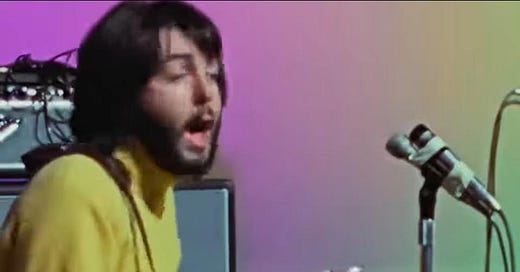Open on the Beatles. In studio at Abbey Road. Morning.
After some chit-chat, Paul starts strumming his Hofner 500/1 bass. It’s a to-tapping, bluesy number. George and Ringo look on like two guys who have not had their fill of English Breakfast tea.
Paul strums on and starts to make some sounds with his voice. Not words, per se. More like scats.
Soon enough, George and Ringo join in. There’s suddenly a chorus. All three lads are singing, “Get back…get back…get back…”
And then the scats come back.
By then John has joined in and we begin to hear more of the familiar strains of the song, Get Back. A song that became one of the Beatles’ biggest number 1 hits — in almost every single market.
I began my presentation on “The Conditions for Breakthrough Creativity” to the TBWA global management folks with this 4-minute clip because it allows the audience to actually witness creativity happen right before their eyes.
Now, geniuses notwithstanding, the Beatles pretty much subscribe to all of the conditions for breakthrough creativity that I have extrapolated, experienced and expressed.
At the conference, I presented seven of the conditions due to time constraints. I’ll share all ten of them with you here.
Condition 1: Pursuit
Everyone needs to be aligned on what the objective is. Big or small — everyone on both client and agency side must be working towards the same goal.
Condition 2: Prioritize
I began this section with a quote from Jerry Seinfeld. He explained the priorities of one of the world’s most enduring and successful TV shows. He said he and partner Larry David spent their time as follows: “99% witting. 1% managing.”
Now in this day and age, it’s hard for a creative company to operate with that kind of extreme creative priority, but it does feel that companies today spend 99% of their time on finance, technology and operations, no?
I have a framework called the Priority Pyramid. It breaks your to-do list into a triangle with three sections: Gold, Silver, Bronze. Gold is Breakthrough work. Silver and Bronze? Everything else.
The message? If you can’t spend 99% of your time on your creative product, at least spend the majority of your time focused on what’s Gold.
Condition 3: People
Get the people right. The right mix of skills. The right roles. The right attitudes. Great talent helps, too.
Oh, and if you don’t have enough weirdos, rent them. Plenty available through freelance these days.
Condition 4: Process
If you’re just going to wait for lightning to strike, you might be waiting for a while. You need a process to give yourself the best chance for a “Eureka” moment.
It starts with clearly defining the challenge.
Clarity before insanity.
Condition 5: Psychological Safety
You need an environment where people are free to both dream and say dumb sh*t. Sometimes smart is born from dumb. You also need to know when to be loose and free. And when to make the hard decisions. Think about George and Ringo in the Beatles clip. They didn’t kill anything as Paul sang. They listened without prejudice or bias.
Condition 6: Place
The Beatles had Abbey Road. Lockheed has the SkunkWorks. Pixar has “Story Rooms.” These are spaces built to foster creativity.
At Chiat LA, we used to work in tents. The power of the tent space was the ability to work “horizontally.” To print out work and see it pinned across the wall and on black Gator Foam boards. This process is helpful to connect dots. As Steve Jobs once said, “Creativity is connecting dots.”
Today, there’s too much work on Teams and screens. As I like to say, “side-by-side helps you be way more creative than slide by slide.”
Condition 7: Play
There needs to be time and slack in the system to play with ideas. To prototype. To just see what’s possible. For every ridiculous timeline that’s thrown at you, always ask for two more days so you can play. You might not get two more days, but you might get one more day and that can make all the difference.
Condition 8: Produce
As I was working on this, I had been looking at a lot of the work from the late, great designer, Virgil Abloh. Virgil was a production machine producing everything from hoodies to Mercedes-Benz G-Wagons to IKEA Blankets. (Oh, and several brands of his own and even heading up LVMH for a stint in between.)
The powerful condition he offered up was his “3%” rule. A notion that creativity could begin and end if you simply tried to improve something or make something different by a mere 3% from its original form.
Three percent.
In other words, he lowered the entry point to simply “make stuff.”
Condition 9: Partnership
Michelangelo was able to make magic with his chisel and brush, in part, thanks to the handshakes and agreements with his patrons. In the world of commercial art, creatives and clients need to have a high degree of trust in one another. They may not always agree, but the trust between the two parties and the shared pursuit allows for great things to happen.
Condition 10: Power of Fun
If there’s fun in the process, chances are there will be fun in the product. It’s as simple as that…but, let’s face it, we are living in very fun-challenged times. It will take special effort to block out the noise and keep the pressure at bay so the laughter can emerge.
So there you have it. The 10 conditions for breakthrough creativity.
As you pursue what you’re working on, take a look at your conditions. If you have all 10, chances are you can make something wonderful.
If you only have a few conditions met, what can you do to make the others happen?
Having all 10 conditions won’t guarantee you’ll create something breakthrough. But it’ll sure improve the odds.
Image: The Beatles: Get Back. Directed by Peter Jackson




